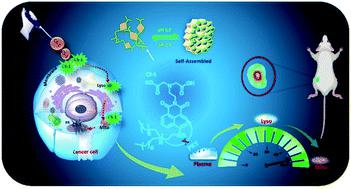当前位置:
X-MOL 学术
›
Chem. Sci.
›
论文详情
Our official English website, www.x-mol.net, welcomes your feedback! (Note: you will need to create a separate account there.)
Self-assembled amphiphilic fluorescent probe: detecting pH-fluctuations within cancer cells and tumour tissues
Chemical Science ( IF 8.4 ) Pub Date : 2020-08-28 , DOI: 10.1039/d0sc03795h Soo Yeon Kim 1, 2, 3, 4 , Arup Podder 5, 6, 7, 8 , Hyunseung Lee 1, 2, 3, 4 , Youn-Joo Cho 1, 2, 3, 4, 9 , Eun Hee Han 1, 2, 3, 4 , Sabina Khatun 5, 6, 7, 8 , Jonathan L. Sessler 10, 11, 12, 13 , Kwan Soo Hong 1, 2, 3, 4, 9 , Sankarprasad Bhuniya 5, 6, 7, 8, 14
Chemical Science ( IF 8.4 ) Pub Date : 2020-08-28 , DOI: 10.1039/d0sc03795h Soo Yeon Kim 1, 2, 3, 4 , Arup Podder 5, 6, 7, 8 , Hyunseung Lee 1, 2, 3, 4 , Youn-Joo Cho 1, 2, 3, 4, 9 , Eun Hee Han 1, 2, 3, 4 , Sabina Khatun 5, 6, 7, 8 , Jonathan L. Sessler 10, 11, 12, 13 , Kwan Soo Hong 1, 2, 3, 4, 9 , Sankarprasad Bhuniya 5, 6, 7, 8, 14
Affiliation

|
Abnormal anaerobic metabolism leads to a lowering of the pH of many tumours, both within specific intracellular organelles and in the surrounding extracellular regions. Information relating to pH-fluctuations in cells and tissues could aid in the identification of neoplastic lesions and in understanding the determinants of carcinogenesis. Here we report an amphiphilic fluorescent pH probe (CS-1) that, as a result of its temporal motion, provides pH-related information in cancer cell membranes and selected intracellular organelles without the need for specific tumour targeting. Time-dependent cell imaging studies reveal that CS-1 localizes within the cancer cell-membrane about 20 min post-incubation. This is followed by migration to the lysosomes at 30 min before being taken up in the mitochondria after about 60 min. Probe CS-1 can selectively label cancer cells and 3D cancer spheroids and be readily observed using the green fluorescence channel (λem = 532 nm). In contrast, CS-1 only labels normal cells marginally, with relatively low Pearson's correlation coefficients being found when co-incubated with standard intracellular organelle probes. Both in vivo and ex vivo experiments provide support for the suggestion that CS-1 acts as a fluorescent label for the periphery of tumours, an effect ascribed to proton-induced aggregation. A much lower response is seen for muscle and liver. Based on the present results, we propose that sensors such as CS-1 may have a role to play in the clinical and pathological detection of tumour tissues or serve as guiding aids for surgery.
中文翻译:

自组装的两亲荧光探针:检测癌细胞和肿瘤组织内的pH波动
异常的无氧代谢会导致特定细胞内细胞器内和周围细胞外区域内许多肿瘤的pH值降低。有关细胞和组织中pH波动的信息可以帮助鉴定肿瘤性病变,并有助于了解致癌因素。在这里,我们报告了一种两亲性荧光pH探针(CS-1),由于其暂时的运动,它可以在癌细胞膜和选定的细胞内细胞器中提供与pH相关的信息,而无需进行特定的肿瘤靶向。时间依赖性细胞成像研究表明CS-1温育后约20分钟定位在癌细胞膜内。随后在30分钟时迁移至溶酶体,然后在约60分钟后被线粒体吸收。探头CS-1可以选择性标记癌细胞和癌症三维球状体和使用该绿色荧光通道(被容易地观察到λ EM = 532纳米)。相反,CS-1仅少量标记正常细胞,与标准细胞内细胞器探针共同孵育时,发现相对较低的Pearson相关系数。无论在体内和体外实验提供支持该建议是CS-1充当肿瘤外围的荧光标记,归因于质子诱导的聚集。肌肉和肝脏的反应要低得多。基于目前的结果,我们建议诸如CS-1的传感器可能在肿瘤组织的临床和病理检测中发挥作用,或作为手术的指导手段。
更新日期:2020-09-23
中文翻译:

自组装的两亲荧光探针:检测癌细胞和肿瘤组织内的pH波动
异常的无氧代谢会导致特定细胞内细胞器内和周围细胞外区域内许多肿瘤的pH值降低。有关细胞和组织中pH波动的信息可以帮助鉴定肿瘤性病变,并有助于了解致癌因素。在这里,我们报告了一种两亲性荧光pH探针(CS-1),由于其暂时的运动,它可以在癌细胞膜和选定的细胞内细胞器中提供与pH相关的信息,而无需进行特定的肿瘤靶向。时间依赖性细胞成像研究表明CS-1温育后约20分钟定位在癌细胞膜内。随后在30分钟时迁移至溶酶体,然后在约60分钟后被线粒体吸收。探头CS-1可以选择性标记癌细胞和癌症三维球状体和使用该绿色荧光通道(被容易地观察到λ EM = 532纳米)。相反,CS-1仅少量标记正常细胞,与标准细胞内细胞器探针共同孵育时,发现相对较低的Pearson相关系数。无论在体内和体外实验提供支持该建议是CS-1充当肿瘤外围的荧光标记,归因于质子诱导的聚集。肌肉和肝脏的反应要低得多。基于目前的结果,我们建议诸如CS-1的传感器可能在肿瘤组织的临床和病理检测中发挥作用,或作为手术的指导手段。



























 京公网安备 11010802027423号
京公网安备 11010802027423号